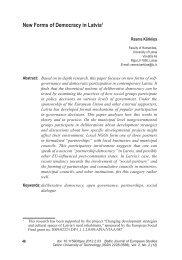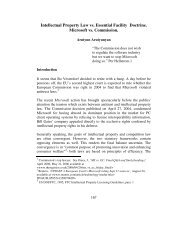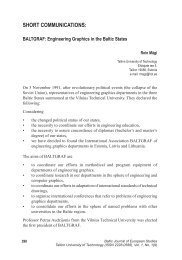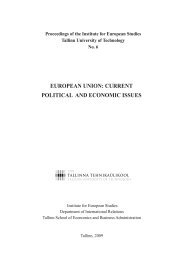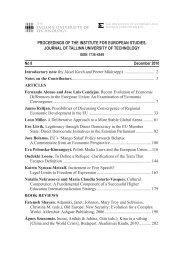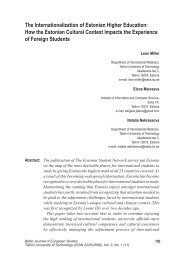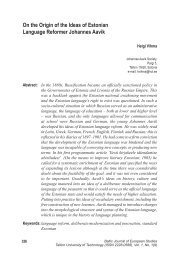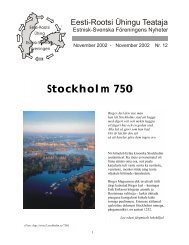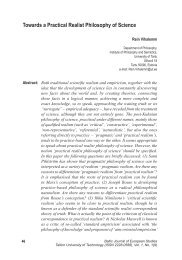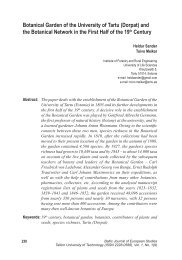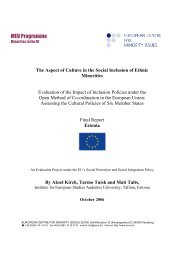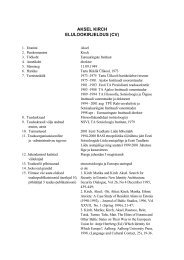Vladimir (Woldemar Justus Konstantin) Malmberg (1860â1921 ...
Vladimir (Woldemar Justus Konstantin) Malmberg (1860â1921 ...
Vladimir (Woldemar Justus Konstantin) Malmberg (1860â1921 ...
You also want an ePaper? Increase the reach of your titles
YUMPU automatically turns print PDFs into web optimized ePapers that Google loves.
<strong>Vladimir</strong> (<strong>Woldemar</strong> <strong>Justus</strong> <strong>Konstantin</strong>) <strong>Malmberg</strong><br />
(1860–1921), Professor of Dorpat and Moscow Universities<br />
<strong>Vladimir</strong> (<strong>Woldemar</strong> <strong>Justus</strong> <strong>Konstantin</strong>) <strong>Malmberg</strong><br />
(1860–1921), Professor of Dorpat and Moscow Universities<br />
Kateryna Gamaliya<br />
Department of the History of Art and Ethnic Culture<br />
Salvador Dali Institute of Art for Decorative Modelling and Design<br />
Berezhanska 5,<br />
Kiev 04 074, Ukraine<br />
e-mail: mixmd@list.ru<br />
Abstract: The creative development of the well-known art historian, Professor<br />
<strong>Vladimir</strong> (<strong>Woldemar</strong> <strong>Justus</strong> <strong>Konstantin</strong>) <strong>Malmberg</strong> (1860–1921),<br />
was connected with several universities: the Kazan University, where<br />
he was a student (1879–1984) and began lecturing as Assistant<br />
Professor (1888–1889); the University of St Petersburg, where he<br />
prepared for professor’s activity (1884–1887); the universities of<br />
Dorpat (now Tartu, 1890–1896) and Moscow (1907–1921), where he<br />
worked as professor during a significant period. Besides lecturing,<br />
he put a great deal of his strength and energy to archaeological<br />
investigations and museum work. The main part of <strong>Malmberg</strong>’s<br />
works was devoted to the history of Ancient Greek culture, but he<br />
also wrote some articles on Ancient Egyptian art, the antiquities of<br />
southern Russia, and the painting of Albrecht Dürer. His creative<br />
contribution to art criticism was appreciated in Russia and abroad.<br />
He was a member of the Imperial Russian Archaeological Society in<br />
St Petersburg, the Society of History and Antiquities in Odessa, the<br />
Associate Member of the Imperial Archaeological Commission and<br />
the German Archaeological Institute in Berlin, Rome and Athens.<br />
Keywords: ancient world, antiquities, archaeology, arts, history, universities<br />
At the end of the 18 th and in the first half of the 19 th century, the history of Ancient<br />
Greece gained importance in European historiography. The most intensive work<br />
in this area took place in Germany. The basics of the scientific history of ancient<br />
art were laid down by Johann Joachim Winckelmann, who created an outstanding<br />
work History of Ancient Art (1764) and “invented an aesthetic scheme which has<br />
deeply affected European attitudes to Greece ever since” (Davies, 1997, p. 96).<br />
Baltic Journal of European Studies<br />
Tallinn University of Technology (ISSN 2228-0588), Vol. 1, No. 1(9)<br />
345
Kateryna Gamaliya<br />
The work generalizing the study of many German historians was a three-volume<br />
monograph by Ernst Curtius, Greek History (1857–1867), in which he devoted<br />
much attention to archaeology and art history. Curtius compared the newest<br />
method for studying the ancient world with the experimental method, which was<br />
then already widely used in natural sciences: quite like natural scientists find<br />
answers to their questions with the aid of experience, archaeologists conduct<br />
methodical archaeology diggings in those places where, according to science,<br />
there are potential sources of solution to their issues. The last third of the 19 th<br />
century was marked by a number of major archaeological discoveries in the<br />
history of Ancient Greece. The most outstanding results were obtained from<br />
excavations made by German researchers Heinrich Schliemann and Wilhelm<br />
Dörpfeld in Troy, Mycenae and Tiryns (1871–1894), as well as by Englishman<br />
Arthur Evans in Crete (1900).<br />
During the same period there was a major breakthrough in the study of the history<br />
of Ancient Egypt. Much credit for this belongs to Adolf Erman, a prominent<br />
Egyptologist and lexicographer, founder of the Berlin School of Egyptology. The<br />
classical works of Erman and his school laid the foundation for modern Egyptology,<br />
affecting the development of this area of science in many countries. Among his<br />
disciples are known researchers such as Alan Gardiner in England, James Breasted<br />
in America, Gulio Farina in Italy, and Boris Turaev in Russia. In the late 19 th century,<br />
major discoveries in the excavations in Egypt were made by French researchers<br />
Gaston Maspero (1881; 1889) and Victor Loret (1898), German Egyptologist Emil<br />
Brugsch (1881), and English archaeologist Flinders Petrie (1884).<br />
Pioneering works in the field of Antique and Ancient Egyptian art disclosed,<br />
according to Ludwig Borchardt, “the most striking lines of the incredible<br />
dialogue of epochs”. However, the recreation of the fullest possible picture of<br />
the history of art of the Ancient World required the hard work of dozens of<br />
researchers from different countries, and one of them was the Russian scientist<br />
<strong>Vladimir</strong> <strong>Malmberg</strong>.<br />
<strong>Vladimir</strong> K. <strong>Malmberg</strong> was born in Moscow on the 1 st of December 1860 in a<br />
merchant’s family. In 1884, he completed a course of History and Philology at<br />
the Department of Classics of the Kazan University. In the autumn of that year,<br />
<strong>Malmberg</strong> was awarded the Candidate of Sciences degree and since March 1,<br />
1885 worked at the University to prepare for a professorship at the Department<br />
of History and Theory of Fine Arts. In this capacity he was seconded to the<br />
University of St Petersburg to study under the guidance of Professor Adrian<br />
V. Prakhov (art historian, archaeologist), Ivan V. Pomialovskii (researcher of<br />
Roman literature, archaeologist) and Petr V. Nikitin (literary historian).<br />
346<br />
Baltic Journal of European Studies<br />
Tallinn University of Technology (ISSN 2228-0588), Vol. 1, No. 1(9)
<strong>Vladimir</strong> (<strong>Woldemar</strong> <strong>Justus</strong> <strong>Konstantin</strong>) <strong>Malmberg</strong><br />
(1860–1921), Professor of Dorpat and Moscow Universities<br />
During the Christmas holidays in 1885, <strong>Malmberg</strong> visited Dorpat (now Tartu),<br />
where Professor Georg Löschcke acquainted him with the university museum.<br />
Over the period of three months in the summer of 1886 in Germany, he attended<br />
the lectures of professors of the University of Berlin, historians of Antiquity,<br />
and archaeologists Ernst Curtius, Johann Adolf Michael Furtwängler and Carl<br />
Robert, and participated in practical exercises conducted by them. In 1887,<br />
his St Petersburg coach Prakhov was sent abroad on a scientific mission, and<br />
to continue his internship, <strong>Malmberg</strong> was relocated to Dorpat to work with<br />
professor Löschcke. In the spring of 1887 he passed the exam for a master’s<br />
degree in Art History and Theory at the University of St Petersburg, and after<br />
reading two trial lectures was awarded the title of assistant professor.<br />
In early 1889, <strong>Malmberg</strong> was appointed to the position of assistant-professor<br />
in the Department of History and Theory of Fine Arts at the Kazan University.<br />
However, in late 1889 the Ministry of Education invited him to take the position<br />
of the acting extraordinary professor of Classical Philology and Archaeology at<br />
the University of Dorpat. He agreed on condition that he would be lecturing only<br />
on the history of ancient art, antiquities of life and cult, and the ancient authors<br />
related to these disciplines. On May 10, 1890 <strong>Malmberg</strong> entered the service at<br />
the University of Dorpat (Biograficheskii slovar’ …, 1903).<br />
History of Ancient Art was a compulsory subject for the students of the department<br />
of Classics, so <strong>Malmberg</strong> annually repeated the course of the History of Greek<br />
and Roman Art. Besides the main subject he lectured Mythology, Greek and<br />
Roman Antiquity, Introduction into Homeric Epics and the Homeric Antiquity,<br />
as well as the works of Greek and Roman authors: Pausanias, Pliny, Vitruvius<br />
and Lucian. As elective subjects he lectured the Overview of Art History for<br />
junior classes and Explanation of Plaster Casts open to all faculties. He carried<br />
out practical exercises in various fields of archaeology, including antiquities<br />
found in Russia, as a result of the Imperial Archaeological Commission<br />
activities (<strong>Malmberg</strong>, 1891). The university lacked funds to buy materials for<br />
demonstrations and workshops, but <strong>Malmberg</strong> managed to get for free 28 plastic<br />
groups, individual statues and busts from the Imperial Academy of Fine Arts.<br />
In the summer of 1892, <strong>Malmberg</strong> was assigned to an expedition to southern<br />
Russia, where he participated in archaeological excavations. In 1894, he was<br />
given an assignment for six months, most of which he spent in Athens. While in<br />
Greece, he took part in the journey to the Greek islands, organized by the German<br />
Archaeological Institute under the guidance of Professor Wilhelm Dörpfeld, the<br />
famous German archaeologist, and visited various places in the Peloponnese and<br />
Delphi. From Greece via Venice, Nuremberg, Cologne and Antwerp, he went to<br />
Baltic Journal of European Studies<br />
Tallinn University of Technology (ISSN 2228-0588), Vol. 1, No. 1(9)<br />
347
Kateryna Gamaliya<br />
London and via Berlin returned to Russia. In 1897, he traveled to Stockholm and<br />
Copenhagen and in 1900 to Paris, Rome, Naples, Pompeii, Florence and Vienna.<br />
Based on his own and other scientists’ archaeological discoveries, <strong>Malmberg</strong><br />
wrote several articles on the history of Ancient Greek culture. In 1889, he<br />
published his work ‘Essays on Ancient Greek art. Some methods of potterypainters’<br />
in Memoirs of the Imperial Russian Architectural Society in St<br />
Petersburg. In 1899, his article on the history of the study of military arms of the<br />
ancient Greeks was published in Scientific Proceedings of the Imperial Kazan<br />
University. He wrote that in 1838 the Englishman Charles Fellows found basrelief<br />
images of the fourth-century warriors carrying round shields with pieces<br />
of cloth-like dense mats attached. Later these boards with mats made of cloth or<br />
leather were found in figures depicted on vases (5 th century) and on sarcophagi<br />
(6 th century). According to <strong>Malmberg</strong> (1890), these mats served to protect the<br />
soldiers’ feet from the arrows of the attackers.<br />
In 1892, <strong>Malmberg</strong>’s work Metopes of the Ancient Greek Temples. Research in<br />
the Field of Decorative Sculpture, was published in Dorpat, and was defended<br />
by him as his master’s thesis. In 1894, after conducting his own research during<br />
a stay in Greece, he amended this work, carried out by studying the publications<br />
of other scientists. After analyzing the relief decoration on all four sides of<br />
the Parthenon, he concluded that the sculptural groups on the pediment and<br />
friezes were created by talented artists based on the models of the famous artist<br />
Polignotus, and the sculpture metope on the north side represents a pattern<br />
borrowed from another, less-known master (<strong>Malmberg</strong>, 1894).<br />
In 1904 <strong>Malmberg</strong> defended, in St Petersburg, his doctoral thesis on Ancient<br />
Greek Pediment Compositions, in which he noted that the marble figures of<br />
the pediments were painted in ancient times with a predominance of red color<br />
and stood out against a dark blue or light blue background. In 1907, he became<br />
professor at the Moscow University, and spent the rest of his life in Moscow.<br />
<strong>Vladimir</strong> Pavlov (1962, p. 45) recalled: “I had the good fortune to listen to his<br />
lectures on Egyptian Art. He not as much analyzed the monument, but mostly<br />
described it, and the statue came to life in these descriptions, became soulful”.<br />
As in the University of Dorpat, professor <strong>Malmberg</strong>, during his lectures, showed<br />
photos and drawings, and during the sessions at the museum – original works<br />
of art, or plaster casts and copies. For larger audiences he insisted on using<br />
the magic lantern (image projector) during demonstration, as it was done by<br />
Hermann Grimm in Berlin and Adolf Furtwängler in Munich (<strong>Malmberg</strong>, 1896).<br />
In addition to teaching, he put a lot of effort and energy to the museum work.<br />
348<br />
Baltic Journal of European Studies<br />
Tallinn University of Technology (ISSN 2228-0588), Vol. 1, No. 1(9)
<strong>Vladimir</strong> (<strong>Woldemar</strong> <strong>Justus</strong> <strong>Konstantin</strong>) <strong>Malmberg</strong><br />
(1860–1921), Professor of Dorpat and Moscow Universities<br />
In the early 20 th century, the Moscow Museum of Art, now named the Pushkin<br />
State Museum of Fine Arts, was opened. It was based on the Munzkabinett, the<br />
later Cabinet of Fine Arts and Antiquities of the Moscow University, as educational<br />
support and public repository of casts and copies of classic works of world art, and<br />
it was first called the Museum of Plaster Copies Named after Emperor Alexander<br />
III at the Moscow University (Kharko, 1960). The initiative for its creation in 1893<br />
came from Ivan V. Tsvetaev, professor of Moscow University, doctor of Literature<br />
and the Roman historian, who became the first director of the museum. The<br />
museum building was erected under the supervision of architect Roman I. Klein<br />
from 1899 to 1894. The construction was funded by sponsors. At the same time<br />
there were on-going activities on collection and ordering of the future exhibits, in<br />
which <strong>Malmberg</strong> took part. The opening of the museum was held on May 31, 1912,<br />
and in 1913 <strong>Malmberg</strong> was appointed to the position of the director of the museum.<br />
The pride of the museum was a collection of Egyptian antiquities collected<br />
by the famous Russian Egyptologist <strong>Vladimir</strong> S. Golenishchev (1856–1947),<br />
a distant relative of Commander Mikhail Kutuzov. Golenishchev had been<br />
fascinated by Ancient Egypt from a young age, and when he was 14 years old he<br />
acquired his first item which laid the foundation for the future collection. Having<br />
made later more than sixty trips to Egypt, he collected over 6,000 valuable<br />
monuments of Egyptian art, purchased by the Russian state on the occasion of<br />
the opening of the Museum of Fine Arts (Golovina, 2006). Inspired by the study<br />
of Golenishchev’s artifact collection, <strong>Malmberg</strong> seriously engaged himself in<br />
the study of ancient Egyptian art.<br />
Interest in the Egyptian art, derived from the general state of the study of Arts,<br />
has experienced a new surge in the first quarter of the 20 th century. Throughout<br />
this period, Art stood out as the object of independent study in various fields<br />
of cultural history. The first special researches into art history, including Egypt,<br />
appeared in Western Europe. The work by Gaston Maspero from 1887 highlighted<br />
important issues of the artistic culture of Egypt and was titled L’archéologie<br />
égyptienne; in 1912 he outlined the same problem in a more profound form<br />
in a book titled Essais sur l’art égyptien. The emancipation of the history of<br />
Egyptian art from the general Egyptian studies eventually prevailed; its focus<br />
was not only the general patterns of development, but also separate directions,<br />
schools and artists. A variety of tasks of the young discipline of Egyptian Art<br />
History could be accomplished with the help of original materials assembled in<br />
the Department of Egyptian Antiquities of the Museum of Fine Arts.<br />
The result of <strong>Malmberg</strong>’s creative exploration was a series of works devoted to<br />
the attribution of the exhibits of the museum, the largest of which was written<br />
Baltic Journal of European Studies<br />
Tallinn University of Technology (ISSN 2228-0588), Vol. 1, No. 1(9)<br />
349
Kateryna Gamaliya<br />
jointly with Boris A. Turaev (<strong>Malmberg</strong> & Turaev, 1917). An article, published<br />
in 1915, and polemical in its nature, devoted to discussing the methods of<br />
composition of human body in the works of Ancient Egyptian art, holds a<br />
special place in his work. The human figure, shown with expanded shoulders<br />
and upper part of the body from the front, and legs in profile, first appeared in the<br />
painted figures and in reliefs during Dynasty I, and remained such throughout<br />
the period of Ancient Egyptian art (Pavlov, 1936). In the study of art this method<br />
was given various explanations and interpretations. In the late 19 th and early 20 th<br />
century the dominating opinion, the most important representative of which was<br />
Bissingen, insisted that Egyptian artists sought to portray the human body in all<br />
three dimensions. Erman was in agreement with such an interpretation:<br />
The dominant style in the Egyptian painting affects us primarily with<br />
a strange interpretation of the human figure. In an effort to show<br />
every part of the body from the point of view which for us is the most<br />
characteristic, Egyptian artists painted such a body with the strange<br />
twists that are completely contrary to reality. In general, the figure is<br />
conceived in profile, as evidenced by the head, arms, legs and feet.<br />
But in this profile an eye is placed en face, and the main confusion<br />
is in the torso, namely, the shoulders are visible from the front, while<br />
the tibia put in the profile, and chest and stomach should serve as<br />
intermediate link between them. With regard to the chest, then this is<br />
reflected by the fact that the posterior contour shows the outline of<br />
it [the torso] en face, and the front – in profile, the lower abdomen<br />
should be thought about three-quarters, as it shows the position of<br />
the navel. (Erman, 1923)<br />
<strong>Malmberg</strong> was the first to dispute this view, which was present in all textbooks<br />
on the history of art, insisting that it is about using only two dimensions:<br />
I am – convinced that just the opposite – in the Egyptian picture,<br />
with the unfolded shoulders we never have the torso in front, but<br />
always from the side, as proven through its contour: one is always<br />
contour of the chest and abdomen, the other – back and the bottom.<br />
Excessive expansion of the body is due to the image of both shoulders<br />
and the need to drive the external contours of the body to the armpits.<br />
(<strong>Malmberg</strong>, 1915)<br />
And then concludes, “So, you could not talk about the inability of Egyptian<br />
artists to draw person on the plane surface, but only the desire to express<br />
three dimensions using the two most characteristic ones: the profile image is<br />
350<br />
Baltic Journal of European Studies<br />
Tallinn University of Technology (ISSN 2228-0588), Vol. 1, No. 1(9)
<strong>Vladimir</strong> (<strong>Woldemar</strong> <strong>Justus</strong> <strong>Konstantin</strong>) <strong>Malmberg</strong><br />
(1860–1921), Professor of Dorpat and Moscow Universities<br />
combined with expanded shoulders and put en face eye” (<strong>Malmberg</strong>, 1915,<br />
p. 16). Although the position of <strong>Malmberg</strong> was also controversial, his ability<br />
to be critical of the conclusions of a recognized authority deserves respect.<br />
In terms of the particular issue it is interesting to understand the view of<br />
Borchardt, who believed that the artist, drawing a figure, did not intend to<br />
create a common track, but constructed it from separate body parts that is<br />
close to the principles of children’s drawings. Such drawing should be read<br />
like a letter, not to be perceived as a whole. Its strange proportions were caused<br />
by the desire to most accurately portray the individual items in their reality<br />
(Gess, 1921).<br />
<strong>Malmberg</strong>, professor of the Moscow University, also lectured at the Imperial<br />
Archaeological Institute Named after Nicholas II, the institution established by<br />
private funds for the “scientific development of archaeology, archaeography<br />
and Russian history, with the supporting disciplines”. The institute, which was<br />
opened in Moscow in 1907, admitted students with higher education, others<br />
could audit the courses. The education was scheduled for three years; the third<br />
year was devoted to archaeological excavations and studies in the archives.<br />
Lectures were given by the best specialists: philologist Sergei I. Sobolewskii,<br />
archaeologist Vassili A. Gorodtsov, art historian <strong>Vladimir</strong> K. <strong>Malmberg</strong>, and<br />
others. Occasionally, prominent scientists read the special courses. For example,<br />
the Russian artist Nicholas Roerich had chosen the following topic for his<br />
lectures – Applying Artistic Techniques in Archaeology.<br />
In the first years of its existence, the Nicholas II Archaeological Institute occupied<br />
leased premises but then, at the expense of sponsors, mostly S. P. Ryabushinskii,<br />
a special building was constructed to host the institute. The construction works<br />
started on May 24 th , 1913, on the day of celebrating the 300 years of the<br />
Romanov’s dynasty, and in 1914 lectures were already conducted in the new<br />
building. The institute has opened branches in other cities of Russia: Smolensk,<br />
Nizhny Novgorod, Vitebsk, Kaluga, Yaroslavl and Rostov. The journal Notes of<br />
the Moscow Nicholas II Archaeological Institute, as well as individual works<br />
of researchers were published periodically; scientific expeditions around Russia<br />
and abroad were conducted; opening of the Russian Archaeological Institute in<br />
Rome was planned. But in the Soviet times the activities of the institute, which<br />
existed on donations and fees, ended.<br />
<strong>Malmberg</strong>’s works were known both in Russia and abroad. Together with a<br />
group of Russian scientists he participated in many international congresses,<br />
making reports on various topics, in particular: ‘Gold artifacts found in<br />
Hersonissos’ (1 st International Archaeological Congress in Athens, 7–13<br />
Baltic Journal of European Studies<br />
Tallinn University of Technology (ISSN 2228-0588), Vol. 1, No. 1(9)<br />
351
Kateryna Gamaliya<br />
April 1905), ‘On Belvedere Torso’ (International Archaeological Congress in<br />
Rome, 9–16 October 1912). In 1917, the Russian colleagues expressed their<br />
respect to <strong>Vladimir</strong> K. <strong>Malmberg</strong>, dedicating to him the Digest of the Moscow<br />
Society for the Exploration of Ancient Monuments named after A. I. Uspenski<br />
at the Moscow Archaeological Institute. The digest included articles by such<br />
prominent specialists as Boris A. Turaev, Mikhail I. Rostovtsev, Voldemar K.<br />
Shileiko, Alexey V. Nazarevsky, and others. Nikolay A. Shcherbakov presented<br />
a list of the works of professor <strong>Malmberg</strong>, consisting of more than 50 positions<br />
(Sbornik Moskovskogo obshchestva…, 1917). Several years later, <strong>Malmberg</strong><br />
was gone. He died in Moscow on December 9, 1921.<br />
The Pushkin State Museum of Fine Arts continues to be a place of interest<br />
– a treasury of world art, a research center in the field of culture and art, an<br />
educational institution. Since the time of the first publications of <strong>Vladimir</strong> K.<br />
<strong>Malmberg</strong>, many new discoveries have been made, and many original ideas<br />
and concepts have been generated. But it all highlights the contribution that he<br />
and his colleagues, the first Russian Egyptologists, have made in the course of<br />
creating the museum and studying its remarkable collections.<br />
Besides his research and lecturing activities, professor <strong>Malmberg</strong> was known in<br />
the field of the organizational-scientific work. He was a member of the Imperial<br />
Russian Archaeological Society in St Petersburg, the Society of History and<br />
Antiquities in Odessa, the Moscow Society of the Exploration of Ancient<br />
Monuments named after A. I. Uspenski, and the Associate Member of the<br />
Imperial Archaeological Commission and the German Archaeological Institute<br />
in Berlin, Rome and Athens.<br />
References:<br />
Biograficheskii slovar´ professorov i prepodavatelei Imperatorskogo Yurievskogo,<br />
byvshego Derptskogo, universiteta za sto let ego sushchestvovaniia, 1802–1902<br />
(1903), vol. 2. Yuriev: K. Mattisen.<br />
Davies, N. (1997), Europe. A History. London: Pimlico.<br />
Erman, A. (1923), Ägypten und ägiptisches Leben im Altertum. vol. 2, Tubingen: Verlag<br />
der H. Lauppschen Buchhandlung.<br />
Gess, F. F. (1921), ‘Kompozitsiia chelovecheskoi figury v egipetskom risunke i rel´efe.’<br />
Izv. Ross. Akademii istorii material´noi kul´tury, vol. 1, pp. 73–94.<br />
Golovina, V. A. (2006), ‘V. S. Golenishchev: osnovnye vekhi biografii.’ Vestnik drevnei<br />
istorii, vol. 4, pp. 170–173.<br />
352<br />
Baltic Journal of European Studies<br />
Tallinn University of Technology (ISSN 2228-0588), Vol. 1, No. 1(9)
<strong>Vladimir</strong> (<strong>Woldemar</strong> <strong>Justus</strong> <strong>Konstantin</strong>) <strong>Malmberg</strong><br />
(1860–1921), Professor of Dorpat and Moscow Universities<br />
Kharko, L. P. (1960), Munz-kabinet Moskovskogo universiteta. Tr. Gosud. muzeia<br />
izobrazit. iskusstv im. A. S. Pushkina. Moskva, pp. 340–372.<br />
<strong>Malmberg</strong> V. K. (1890), K voprosu o drevnegrecheskom vooruzhenii. Shchity s<br />
kovrikami. Kazan: Izdatel´stvo Kazanskogo universiteta.<br />
—— (1892), ‘Drevnosti Iuzhnoi Rossii. Opisanie nekotorykh drevnostei, naidennykh v<br />
Khersonese v 1888–1889 godakh.’ Materialy po arkheologii Rossii, izdavaemye<br />
Arkheologicheskoi komissiei, no. 7, pp. 1–31.<br />
—— (1894), ‘Zametki k voprosu o metopakh Parfenona.’ Uch. zapiski Imp. Yurievskogo<br />
un-ta. no. 4, pp. 3–22.<br />
—— (1896), ‘Uspekhi sovremennoi arkheologii.’ Aktovaia rech´, proiznesennaia 12<br />
dekabria 1895 g. (Speech delivered on 12 December 1895), Yuriev.<br />
—— (1915), Staryi predrassudok. K voprosu ob izobrazhenii chelovecheskoi figury v<br />
egipetskom rel´efe. Moskva: Izdatel´stvo Moskovskogo universiteta.<br />
<strong>Malmberg</strong>, V. K. & Turaev, B. A. (1917), Opisanie egipetskogo sobraniia, I. Statui i<br />
statuetki Golenishchevskogo sobraniia. Petrograd.<br />
Pavlov, V. V. (1936), Ocherki po iskusstvu Drevnego Egipta. Moskva: Gosud. izd-vo<br />
izobrazit. iskusstv.<br />
—— (1962), ‘Otdel drevnego vostoka GMIN i nauka o egipetskom iskusstve za 50 let.’<br />
50 let Gosudarstvennomu muzeiu izobrazitel´nykh iskusstv im. A. S. Pushkina: Sb.<br />
statei. Moskva: Izd-vo Akademii khudozhestv, pp. 42–51.<br />
Sbornik Moskovskogo obshchestva po issledovaniiu pamiatnikov drevnosti im. A. I.<br />
Uspenskogo pri Moskovskom arkheologicheskom institute. (1917), Vyp. 2. V chest’<br />
professora V. K. Mal´mberga. Moskva: Izdatel´stvo Moskovskogo universiteta.<br />
Baltic Journal of European Studies<br />
Tallinn University of Technology (ISSN 2228-0588), Vol. 1, No. 1(9)<br />
353



